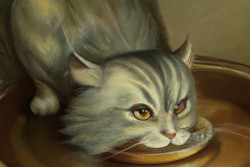
Reptile pets meet many of the criteria currently driving pet ownership growth. Reptiles tend to be small, low-maintenance, hypoallergenic and quiet, which makes them ideal for pet owners in urban areas. As pet owners increasingly live in cities, people have been gravitating towards smaller dogs and cats, but reptile ownership has grown at an even faster rate, especially among younger pet owners. Between 2018 and 2022, reptile pet ownership increased from 18% to 29% among Generation Z in the United States, according to the American Pet Products Association’s latest National Pet Owners Survey. Six million U.S. households now include a reptile pet. Riding that cold-blooded wave, reptile product producer Zilla partnered with multi-platinum recording artist 24kGoldn and his recently adopted Bearded Dragon named Puff.
“Reptiles used to be thought of as unusual pets but have really transitioned to companions, even becoming part of the family for people,” Ernie Katris, head of marketing and innovation for Zilla for Petfood Industry. “We are seeing reptile owners becoming younger therefore, they tend to be significantly more influenced by their media and content on digital and social channels. Younger generations celebrate reptiles to express themselves by having a connection to a unique and sometimes misunderstood animal… Puff, an orange morph bearded dragon, will star in the brand’s ‘Rep Yourself’ campaign that encourages reptile owners to express themselves and celebrate what sets them and their beloved pets apart from everyone else. The ‘Rep Yourself’ campaign is part of a comprehensive brand refresh created to reflect the modern and unique ethos of its current customer base.”
As more people bring reptile pets into their homes, those pet owners look for many of the same qualities in reptile food as in other pet foods. Although a small part of the overall industry, reptile pet foods have been ahead of the game on many trends, including raw meat, whole prey, fresh and insect-based. Yet, humanization and premiumization may not be as obvious in reptile food as in mammal munchies. In dog and cat foods, human diet trends influence pet food demands. However, many reptiles need very different diets than humans. Few people dine on raw rats or live dubia roaches. Likewise, few snakes or leopard geckos will accept a processed diet. Even those reptiles that will eat pelletized foods have dietary needs that don’t resemble those of dogs, cats or humans.
“Humanization of pet food in the reptile category has primarily impacted foods in terms of ingredients,” Katris said. “Like human food, pet parents are searching for all-natural foods for their pets with limited additives and whole ingredients. We have seen this play out with the inclusion of whole fruits and vegetables like peas, greens, and fruit chunks. Often the ingredients are dried and simply require the addition of water to rehydrate. Zilla’s Reptile Munchies contain dehydrated pieces of vegetables and insects that are quick and convenient to feed with no refrigeration required. All pet parents need to do is add water along with calcium and vitamin supplements. The natural ingredients are ideal for feeding alone, in addition to leafy greens, pellet diets, or as treats. Foods containing whole protein sources have also become popular, for example, dried whole shrimp, dried worms, and other insects.
“Speaking of insects, many reptiles prefer live foods and we have seen more and more suppliers offering live crickets, mealworms, and waxworms. For those who prefer to give their reptiles live foods, Zilla offers vitamin and supplement sprays to ensure the reptiles are getting the nutrients they need to stay happy and healthy.
“People want to feed their pets the best food they can to express their love for their animals,” he said. “Humans want to eat healthy and delicious food to feel good, and we want that same experience for our pets…Reptile owners want to feed their pets the best foods they can and are willing to pay up to do so. When compared to processed pellet reptile foods, retailers and brands specializing in dried natural foods and whole-ingredient foods, including live, can charge more for their offerings and people are willing to pay for the higher quality items. Ultimately, it comes down to wanting to do what is best for their reptile friend.”
Reptile food ahead on whole-prey, fresh, frozen trends
Reptile pet premiumization expresses itself in the quality of the foods eaten by snakes’, lizards’ and crocodilians’ prey. For herbivorous reptiles, premiumization plays out in the fruits and vegetables fed to turtles and lizards or used as ingredients to make pellets and other extruded diets and treats.
Along with their diets, the quality of life for prey animals plays a major role in the premiumization of reptile food. Rats and mice serve as pets themselves, and many reptile owners want to know that prey rodents live as comfortably and hygienically as any pet before becoming food. The food eaten by those rats and mice ultimately becomes nutrition for the reptiles, likewise for the insects fed to smaller carnivorous reptiles. Any deficiencies or contamination in prey items’ diets gets passed on to pets.
For insect prey items, reptile pet owners use a process known as gut loading. This involves feeding a nutritious diet to the insects before giving them to pets. This ensures that the insects provide a wholesome range of proteins, carbohydrates and fats to the reptiles. Some vendors advertise that their insects have been gut-loaded before sale.
Feeding live gut-loaded black soldier fly larvae to leopard geckos doesn’t tend to raise animal welfare red flags, but rodents can be more contentious. Reptile pet owners debate whether feeding pre-killed prey is natural, but few debate that it is both more humane for rodents and safer for reptile pets. Snake owners demand that those rodents died quick, painless deaths. In most cases, rodents are suffocated with carbon dioxide, which causes unconsciousness in less than a minute at high levels. Humans who have been knocked out by high concentrations of CO2 describe not feeling anything before they black out. While this makes the gas particularly risky for workers in dry ice plants, it means mice and rats can be killed quickly and presumably painlessly. The rodents can then be frozen and stored for sale by retailers. Numerous companies sell frozen, pre-killed rodents online, distributed through the mail. Those rodent companies differentiate by marketing the speed of delivery, cleanliness of production facilities, the nutritional quality of the foods fed to prey and the prey’s quality of life.
Sausage for snakes and upcycled turtle food
For reptile owners who want to avoid looking pet food in the eyes, one company provides sausages for reptiles. Reptilinks makes sausages from whole animals, including bullfrogs, rabbits, quail and iguana. The company also makes whole-prey sausages for dogs. There aren’t many other examples of carnivorous reptile foods designed to resemble human foods unless you count animals like crickets that are eaten by people and reptiles.
Insects blur the line between reptiles and human food, but fruits and vegetables cross right over that line. Many turtle or lizard owners feed their pets with produce from the grocery store. Some pamper their box turtles and bearded dragons with choice produce, but reptiles eat oddly shaped berries and over-ripe bananas with just as much gusto. Upcycling is nothing new for reptile owners.
Premiumization trends entered the reptile and other pet food markets primarily because pet owners increasingly view animals as family on par with human members. However, humanization of pets isn’t as new of a trend as people tend to think. Since pre-history, people have assigned human attributes to animals and vice versa. Long before there was a web-slinger in New York or a dark knight in Gotham, Anansi the spider-man outsmarted bigger opponents in West Africa and Camazotz the bat-man ruled the night in Central America. The Pucá blurred the lines between human and animal in Ireland and other Celtic lands. Sobek, the crocodile-headed god of Egypt, blended human and reptile. Even in generally anti-serpent Christianity, Jesus compared himself to a snake in John 3:14-15, referring to Moses’ life-saving bronze snake on a staff from Exodus, leading to imagery of crucified serpents in medieval and renaissance art.
Humanization of reptile pets
Despite the historic humanization and deification of reptiles, scaly animals lack an essential characteristic to be fur babies. Nevertheless, pet owners do consider their cold-blooded pets with warmth. In a survey by Packaged Facts, 85% of “other pet” owners, a catch-all category that included reptile owners, considered their pets to family members, in the 2020 report “Reptile Products: U.S. Pet Market Trends and Opportunities.”
“The ‘reptiles as family’ trend further suggests new opportunities for premiumization along the lines of supplies ever more reminiscent of what a reptile would experience in the wild,” Packaged Facts analyst wrote.
Packaged Facts analysts noted that reptile pets’ take up less space in a home and therefore meet younger and urban pet owners demands for smaller pets. Food and other expenses for pets tend to be lower than those of dogs, cats and other warm-blooded pets. Economic considerations now have urgency as unprecedented unemployment weakens already ailing communities.
Humanization of reptile pets provides another step toward understanding the similarities among all living things. Reptile pets teach people what scientists observe as well: animals differ from humans by degrees, but not by kind. Similar nerve pathways fire in the brains of reptiles and humans, a point popularized by neuroscientist Paul MacLean, Ph.D., with the triune brain model. In that model, the reptile portion of our brains corresponds to the regions responsible for basic survival. Those behaviors consist of the four Fs: Feeding, Fleeing, Foraging and Fornicating.
Considering that feeding is one of those behaviors, the premiumization of reptile food along with other pet foods makes sense. The emotional state of a leopard gecko after finding plump, well-hydrated mealworms, may not be that different from a human gazing upon a properly stocked buffet.
Humanization and premiumization of pet foods march together in lockstep, even for pets without legs.














